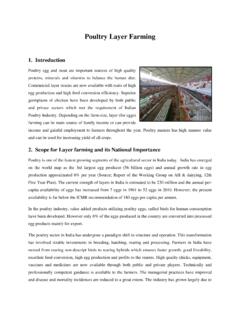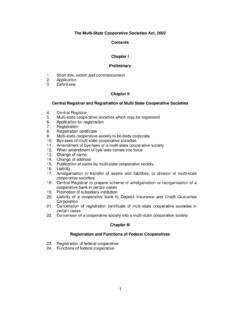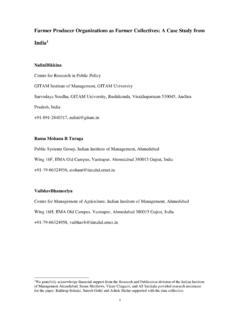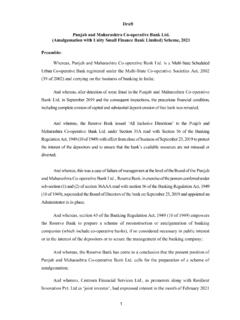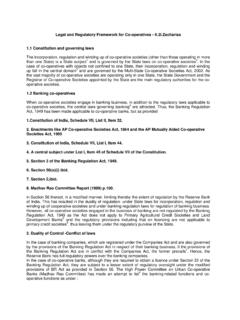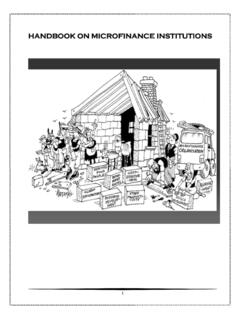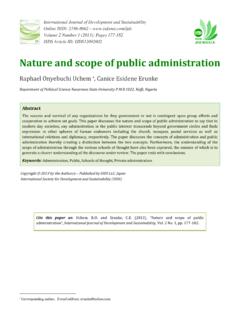Transcription of Frequently Asked Questions (FAQs)
1 NABARDFARMERPRODUCERORGANISATIONSF requently Asked Questions (FAQs)National Bank for Agriculture Mumbai and Rural Development2015 The issue of profitability of small holding based agriculturehas assumed importance in view of increasing proportion ofsmall and marginal farmers in the country. I propose tosupplement NABARD s Producers organization developmentfund for Producer s development and upliftment calledPRODUCE with a sum of Rs 200 crore which will be utilizedfor building 2,000 producers organizations across the countryover the next two years. Shri Arun Jaitley, Hon ble Union Finance Minister, Govt. of IndiaNABARD S MISSIONP romote sustainable and equitable agriculture and rural prosperity through effective credit support, related services, institution development and other innovative PRODUCERORGANISATIONSF requently Asked Questions (FAQs)National Bank for Agriculture Mumbai and Rural Development2015 Title:Farmer Producer Organisations - Frequently Asked Questions (FAQs) Written and Published by:Farm Sector Policy Department & Farm Sector Development Department, NABARD Head Office, Mumbai Date of Publishing:March 2015 Design & Printing:M/s Image ImpressionContact:Plot No C-24, 'G' Block, Bandra Kurla Complex,Bandra East, Mumbai 400051.
2 : +91 22 26539843 Website: , 2015 National Bank for Agriculture and Rural DevelopmentUnless otherwise stated in this document, no part of this document may be reproduced or transmitted in any form by any means without the written authorization from National Bank for Agriculture and Rural Development (NABARD) sincerely acknowledges the efforts of Shri K K Gupta, former Director, Bankers Institute of Rural Development (BIRD) Lucknow and his team of Faculty Members who have made significant contribution in bringing out this Manual on Farmer Producer Organizations. Special thanks are due to Faculty Members of BIRD viz. Shri D. Nageswara Rao (Coordinator), Shri Shirsalkar, Shri Jaideep Srivastava, Shri Srivastava, Shri Maheshwar Sahoo, Shri Rawat and Shri Shariff, for collating information from different sources and organizing various chapters in a sequential manner.
3 They have taken due care in drafting and editing the contents in a user friendly way. Shri Sunil Chawla, Joint Director, Dr. Sharma, Shri Niraj Kumar Verma and Shri KL Vinaya, Faculty Members of BIRD have also given their help in proof reading and improving the contents of the manual. The access to the material and information from earlier manuals and resources on the subject developed, inter alia, by Department of Agriculture and Cooperation (DAC) in Ministry of Agriculture, Govt. of India, Small Farmers Agribusiness Consortium (SFAC) as also Dr. Amar KJR Nayak, Professor of Management & Centre Director, National Centre for Sustainable Community Systems, Lal Bahadur Shastri National Academy of Administration, Mussoorie and Action for Social Advancement (ASA), Bhopal, is sincerely acknowledged.
4 Conceptualization and development of manual would not have been possible without the continued encouragement, support and guidance of Dr. Harsh Kumar Bhanwala, Chairman NABARD, Shri R Amalorpavanathan and Shri H R Dave, Deputy Managing Directors of NABARD. Also, the initiatives taken and efforts put in by Dr. P Radhakrishnan, Chief General Manager, Dr. A R Khan and Shri Sanjay Kumar Dora, Deputy General Managers in coordinating with BIRD and other organizations/ departments in bringing out this manual, are greatly acknowledged. Dr. B G Mukhopadhyay Chief General Manager Farm Sector Development Department NABARD Head Office, Mumbai Contents Chapters Particulars Page No.
5 1 Concept of Producer Organisation 1 2 Producer Organisation Registered as cooperative Society 15 3 Producer Organisation Registered as Producer Company 19 4 Producer Organisation Registered as Non-Profit Society 33 5 Producer Organisation Registered as Trust 36 6 Producer Organisation Registered as Section 8 Company 39 7 Business Planning 42 8 Financial Management 55 9 Funding Arrangement 60 10 Monitoring by the PO, POPI and Funding Agencies 80 Attachment 1 Producer Company Act provisions 86 2 PRODUCE Fund Operational Guidelines 106 3 SFAC Circular on Promoting / supporting Producer Companies 114 4 Case Study on Bilaspur Model of PO 125 5 Indicative Framework of the process of forming a PO 131 6 References 138 7 Memorandum of Agreement between NABARD and POPI 139 8 Memorandum of Understanding between NABARD and RSA 143 9 Abbreviations 146 The Objective of this Manual is to act as a guide to Producer Organisation Promoting Institutions (POPIs) in Promoting and Capacity Building of Producer Organisations (POs)
6 And help POs towards better Management and Business Development. 1 CHAPTER 1 Concept of Producer Organisation What is a Producer Organisation (PO)? A Producer Organisation (PO) is a legal entity formed by primary producers, viz. farmers, milk producers, fishermen, weavers, rural artisans, craftsmen. A PO can be a producer company, a cooperative society or any other legal form which provides for sharing of profits/benefits among the members. In some forms like producer companies, institutions of primary producers can also become member of PO. What is the need for PO? The main aim of PO is to ensure better income for the producers through an organization of their own.
7 Small producers do not have the volume individually (both inputs and produce) to get the benefit of economies of scale. Besides, in agricultural marketing, there is a long chain of intermediaries who very often work non-transparently leading to the situation where the producer receives only a small part of the value that the ultimate consumer pays. Through aggregation, the primary producers can avail the benefit of economies of scale. They will also have better bargaining power vis- -vis the bulk buyers of produce and bulk suppliers of inputs. What is a Farmers Producer Organisation (FPO)? It is one type of PO where the members are farmers.
8 Small Farmers Agribusiness Consortium (SFAC) is providing support for promotion of FPOs. PO is a generic name for an organization of producers of any produce, , agricultural, non-farm products, artisan products, etc. Can there be a PO for non-farmers? Yes. The PO is an organization of the primary producers. If the produce in question is a non-farm item (for example, handloom or handicraft), then the PO will be that of non-farmers. The objective of the PO is to ensure better income realization to its members (who are producers) through aggregation and, if feasible, value addition. What are the essential features of a PO? a. It is formed by a group of producers for either farm or non-farm activities.
9 B. It is a registered body and a legal entity. c. Producers are shareholders in the organization. d. It deals with business activities related to the primary produce/product. e. It works for the benefit of the member producers. f. A part of the profit is shared amongst the producers. g. Rest of the surplus is added to its owned funds for business expansion. Who owns the PO? The ownership of the PO is with its members. It is an organization of the producers, by the producers and for the producers. One or more institutions and/or individuals may have promoted the PO by way of assisting in mobilization, registration, business planning and operations.
10 However, ownership control is always with members and management is through the representatives of the members. 2 Who can promote a PO? Any individual or institution can promote a PO. Individual persons or institutions may promote PO using their own resources out of goodwill or with the noble objective of socio-economic development of producers. If, however, the facilitating agency wishes to seek financial and other support, then they have to meet the requirements of the donor/financing agency. Who provides support for promotion of PO? NABARD, SFAC, Government Departments, Corporates and Domestic & International Aid Agencies provide financial and/or technical support to the Producer Organisation Promoting Institution (POPI) for promotion and hand-holding of the PO.







